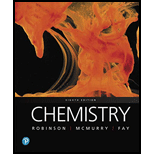
(a)
Interpretation:
The change in the number of moles of
Concept introduction:
According to Le Chatelier’s principle, if equilibrium is disturbed by changing the number of moles, pressure and temperature, the equilibrium will shift to remove the disturbance. For example, if number of moles or pressure of reactant is increased, the reaction will shift in forward direction to decrease the number of moles or pressure of the reactant.
If temperature is increased, the reaction moves to forward direction for an endothermic reaction and it moves to backward direction for exothermic reaction.
(b)
Interpretation:
The change in the number of moles of
Concept introduction:
According to Le Chatelier’s principle, if equilibrium is disturbed by changing the number of moles, pressure and temperature, the equilibrium will shift to remove the disturbance. For example, if number of moles or pressure of reactant is increased, the reaction will shift in forward direction to decrease the number of moles or pressure of the reactant.
If temperature is increased, the reaction moves to forward direction for an endothermic reaction and it moves to backward direction for exothermic reaction.
(c)
Interpretation:
The change in the number of moles of
Concept introduction:
According to Le Chatelier’s principle, if equilibrium is disturbed by changing the number of moles, pressure and temperature, the equilibrium will shift to remove the disturbance. For example, if number of moles or pressure of reactant is increased, the reaction will shift in forward direction to decrease the number of moles or pressure of the reactant.
If temperature is increased, the reaction moves to forward direction for an endothermic reaction and it moves to backward direction for exothermic reaction.
(d)
Interpretation:
The change in the number of moles of
Concept introduction:
According to Le Chatelier’s principle, if equilibrium is disturbed by changing the number of moles, pressure and temperature, the equilibrium will shift to remove the disturbance. For example, if number of moles or pressure of reactant is increased, the reaction will shift in forward direction to decrease the number of moles or pressure of the reactant.
If temperature is increased, the reaction moves to forward direction for an endothermic reaction and it moves to backward direction for exothermic reaction.
Want to see the full answer?
Check out a sample textbook solution
Chapter 15 Solutions
EBK CHEMISTRY
- Please answer the question for the reactions, thank youarrow_forwardWhat is the product of the following reaction? Please include a detailed explanation of what is happening in this question. Include a drawing showing how the reagent is reacting with the catalyst to produce the correct product. The correct answer is IV.arrow_forwardPlease complete the reactions, thank youarrow_forward
- Consider the synthesis. What is compound Y? Please explain what is happening in this question. Provide a detailed explanation and a drawing to show how the compound Y creates the product. The correct answer is D.arrow_forwardWhat would be the major product of the following reaction? Please include a detailed explanation of what is happening in this question. Include steps and a drawing to show this reaction proceeds and how the final product is formed. The correct answer is B. I put answer D and I don't really understand what is going on in the question.arrow_forwardWhat is the product of the following reaction? Please explain what is happening in this question. Provide a detailed explanation and a drawing showing how the reagent is reacting with the catalysts to product the correct product. The correct answer is B.arrow_forward
- What is the missing intermediate 1 and the final product 2. Please include a detailed explanation explaining the steps of malonic ester synthesis. Please include drawings of the intermediate and how it occurs and how the final product is former.arrow_forwardWhat would be the reagents and conditions above and below the arrow that will complete the proposed acetoacetic ester synthesis? If it cannot be done efficiently, then I will choose that answer. There could be 2 or 4 reagents involved. Please provide a detailed explanation and drawings showing how it would proceed with the correct reagents.arrow_forwardFor benzene, the ∆H° of vaporization is 30.72 kJ/mol and the ∆S° of vaporization is 86.97 J/mol・K. At 1.00 atm and 228.0 K, what is the ∆G° of vaporization for benzene, in kJ/mol?arrow_forward
- The reaction Q(g) + R(g) → Z(l) is shown to be exothermic. Which of the following is true concerning the reaction. it is spontaneous only at High T, it is spontaneous at low T it is nonspontaneous at all T it is spontanrous at all T. it is non spontaneous only at low T.arrow_forwardThe reaction Q(g) + R(g) → Z(l) is shown to be exothermic. Which of the following is true concerning the reactionarrow_forwardWhich of the following has the largest standard molar entropy, S° (298.15 K) He H2 NaCl KBr Hgarrow_forward
 Chemistry: Principles and ReactionsChemistryISBN:9781305079373Author:William L. Masterton, Cecile N. HurleyPublisher:Cengage Learning
Chemistry: Principles and ReactionsChemistryISBN:9781305079373Author:William L. Masterton, Cecile N. HurleyPublisher:Cengage Learning Chemistry: Principles and PracticeChemistryISBN:9780534420123Author:Daniel L. Reger, Scott R. Goode, David W. Ball, Edward MercerPublisher:Cengage Learning
Chemistry: Principles and PracticeChemistryISBN:9780534420123Author:Daniel L. Reger, Scott R. Goode, David W. Ball, Edward MercerPublisher:Cengage Learning ChemistryChemistryISBN:9781305957404Author:Steven S. Zumdahl, Susan A. Zumdahl, Donald J. DeCostePublisher:Cengage Learning
ChemistryChemistryISBN:9781305957404Author:Steven S. Zumdahl, Susan A. Zumdahl, Donald J. DeCostePublisher:Cengage Learning Chemistry: An Atoms First ApproachChemistryISBN:9781305079243Author:Steven S. Zumdahl, Susan A. ZumdahlPublisher:Cengage Learning
Chemistry: An Atoms First ApproachChemistryISBN:9781305079243Author:Steven S. Zumdahl, Susan A. ZumdahlPublisher:Cengage Learning
 Chemistry: The Molecular ScienceChemistryISBN:9781285199047Author:John W. Moore, Conrad L. StanitskiPublisher:Cengage Learning
Chemistry: The Molecular ScienceChemistryISBN:9781285199047Author:John W. Moore, Conrad L. StanitskiPublisher:Cengage Learning





